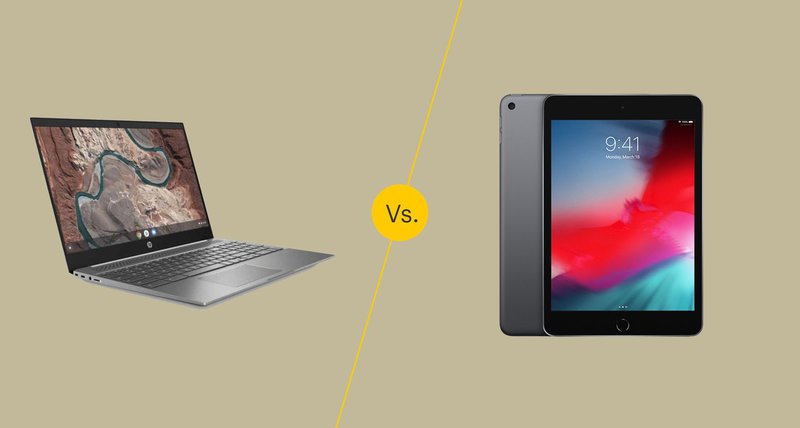Chromebook Vs. Android Tablet: Best Mobile Productivity

In today’s fast-paced digital age, mobile devices have become indispensable tools for individuals seeking to enhance their productivity while on the go. Two prominent options in the market are Chromebooks and Android tablets, both offering distinct features and functionalities.
Chromebooks, powered by Google’s Chrome OS, are known for their seamless integration with cloud-based applications and their ability to provide a laptop-like experience.
On the other hand, Android tablets, running on Google’s mobile operating system, offer a more versatile and touch-centric experience, ideal for media consumption and app usage.
This article aims to objectively compare these devices in terms of performance, operating systems, productivity applications, entertainment capabilities, and value for money. By examining the key features of both devices, readers will be able to make an informed decision when choosing the most suitable device for their mobile productivity needs.
Key Features of Chromebooks
One of the key features of Chromebooks is their seamless integration with Google’s suite of productivity tools, allowing for efficient and collaborative work on various tasks.
Chromebooks come pre-installed with Google Docs, Sheets, and Slides, which are cloud-based applications that enable users to create, edit, and share documents, spreadsheets, and presentations. These tools offer real-time collaboration, allowing multiple individuals to work on the same document simultaneously, making them ideal for teamwork and group projects.
Additionally, Chromebooks provide easy access to Google Drive, where users can store their files and access them from any device with an internet connection. This feature promotes mobility and flexibility, as users can work on their documents from different locations and devices seamlessly.
The integration of Google’s suite of productivity tools enhances the overall productivity and efficiency of Chromebook users.
Key Features of Android Tablets
Key features of Android tablets include a range of applications, high-resolution displays, and portable designs.
Android tablets offer a wide variety of applications, allowing users to customize their devices to suit their specific needs. With access to the Google Play Store, users can choose from a vast array of productivity tools, entertainment apps, and games.
Additionally, Android tablets are known for their high-resolution displays, which provide sharp and vibrant visuals. This makes them ideal for tasks such as reading e-books, watching videos, and viewing images.
Lastly, Android tablets are designed to be portable, making them convenient for on-the-go productivity. They are lightweight and slim, allowing users to easily carry them in a bag or backpack.
Overall, the key features of Android tablets make them a versatile and portable option for mobile productivity.
Comparison of Performance and Processing Power
When comparing the performance and processing power, it is important to consider the hardware specifications and benchmarks of both Android tablets and Chromebooks.
Android tablets generally come in a variety of models with different specifications, such as processor type, RAM capacity, and storage options. Higher-end tablets tend to offer faster processors, more memory, and larger storage capacities, which can contribute to better performance and multitasking capabilities.
On the other hand, Chromebooks are designed to be lightweight and offer a seamless web browsing experience. They typically have lower hardware specifications compared to Android tablets, but their performance is optimized for web-based tasks.
In terms of benchmarks, Chromebooks often outperform Android tablets in web browsing and productivity tasks. However, for more resource-intensive applications and gaming, Android tablets with higher-end hardware specifications may offer better performance.
Ultimately, the choice between an Android tablet and Chromebook depends on the specific needs and preferences of the user.
Operating Systems and User Interface
This discussion focuses on the operating systems and user interface of chromebooks and android tablets.
Firstly, chromebooks operate on the Chrome OS, which provides users with a desktop-like experience. This allows for multitasking and easy access to various applications.
On the other hand, android tablets run on the Android OS, which is specifically designed for mobile devices, offering a more mobile-friendly interface that is optimized for touchscreens.
Additionally, both operating systems offer customization and personalization options, allowing users to tailor their devices to their preferences.
Chrome OS and Desktop Experience
The Chrome OS offers a seamless desktop experience, providing users with a sense of efficiency and productivity. With its lightweight and fast performance, Chrome OS allows users to easily switch between tasks and applications without any lag.
Moreover, the desktop interface of Chrome OS resembles that of a traditional operating system, making it familiar and intuitive for users.
In terms of productivity, Chrome OS offers several features that enhance the overall desktop experience. These include the ability to have multiple windows open simultaneously, a taskbar for quick app access, and a file manager for efficient organization of documents and files.
Additionally, Chrome OS provides seamless integration with Google’s suite of productivity tools, such as Google Docs, Sheets, and Slides, allowing users to effortlessly create, edit, and collaborate on documents.
Chrome OS provides a desktop experience that is efficient, user-friendly, and conducive to productivity. Its seamless interface and integration with productivity tools make it a suitable choice for users seeking a device for mobile productivity.
Android OS and Mobile-Friendly Interface
Android OS provides users with a mobile-friendly interface that is designed to optimize productivity on handheld devices. With its user-friendly layout and intuitive design, Android OS offers a seamless and efficient experience for mobile users.
The operating system’s interface is specifically tailored to meet the needs of mobile users, allowing for easy navigation and quick access to various applications and functions. The home screen offers a customizable layout, enabling users to arrange their apps and widgets in a way that suits their preferences and workflow.
Additionally, Android OS supports multitasking, enabling users to seamlessly switch between different apps and perform multiple tasks simultaneously. With its focus on mobility and productivity, Android OS provides a streamlined and efficient interface for users to maximize their productivity on mobile devices.
Customization and Personalization Options
Customization and personalization options on Android OS allow users to tailor their mobile experience to suit their individual preferences, creating a sense of personal connection and ownership in their device.
Android OS offers a wide range of customization features, enabling users to personalize their device’s appearance, functionality, and overall user experience. Some of the customization options include changing wallpapers, themes, and icon styles to reflect individual tastes.
Additionally, users can customize their home screen layout, add widgets, and rearrange app icons for easy access.
Moreover, Android OS allows users to personalize their notification settings, enabling them to control how they receive alerts and updates.
This level of customization provides users with the ability to create a device that not only meets their specific needs but also reflects their unique personality and style.
Productivity and Work Applications
When considering the best device for mobile productivity, it is important to evaluate the effectiveness and range of productivity and work applications available on each platform.
Chromebooks, being primarily web-based devices, offer a wide array of productivity applications through the Chrome Web Store. Users can access popular applications such as Google Docs, Sheets, and Slides, which are compatible with Microsoft Office files. Additionally, Chromebooks support various collaboration tools, allowing for seamless teamwork and productivity.
On the other hand, Android tablets provide access to a rich ecosystem of applications through the Google Play Store. Productivity applications such as Microsoft Office Suite, Adobe Acrobat Reader, and Evernote are readily available. However, the range of applications optimized for larger screens and advanced productivity features is relatively limited compared to the Chromebook.
Ultimately, the choice between a Chromebook or an Android tablet will depend on the specific productivity needs of the user.
Entertainment and Media Consumption
In the realm of entertainment and media consumption, the selection of available applications and the overall user experience play a crucial role in determining the suitability of a device.
When comparing Chromebooks and Android tablets in this aspect, both devices offer a wide range of applications for entertainment purposes.
Android tablets, being primarily designed for multimedia consumption, provide a vast selection of apps for streaming movies, TV shows, and music. Additionally, the Google Play Store offers a plethora of gaming applications.
On the other hand, Chromebooks also provide access to various entertainment applications, including streaming services and gaming platforms. However, it is worth noting that Chromebooks may have limitations in terms of app availability compared to Android tablets.
Nevertheless, both devices offer a satisfactory entertainment experience, with the final choice depending on personal preferences and specific entertainment needs.
Price Range and Value for Money
For consumers seeking an economical option in terms of price range and value for money, the cost-effectiveness of a device becomes a crucial factor to consider.
In this regard, Chromebooks tend to have a slight advantage over Android tablets. Chromebooks generally offer more affordable options, with a wider range of prices available to suit different budgets. Additionally, the value for money provided by Chromebooks is often considered higher due to their ability to perform tasks traditionally associated with laptops, such as word processing and web browsing, at a lower cost.
On the other hand, while Android tablets can also be found at various price points, they are often more expensive than Chromebooks for comparable specifications and functionality. Therefore, for individuals prioritizing cost-effectiveness and value for money, Chromebooks may emerge as the more favorable choice.
Frequently Asked Questions
Can Chromebooks and Android tablets run the same productivity and work applications?
Chromebooks and Android tablets can run many of the same productivity and work applications. However, the availability and compatibility of specific applications may vary between the two platforms.
Are there any major differences in the user interface between Chromebooks and Android tablets?
The user interface of Chromebooks differs from that of Android tablets. Chromebooks use the Chrome OS interface, which is optimized for web browsing and online applications, while Android tablets use the Android OS interface, which is designed for touch-based navigation and app-centric workflows.
Can Chromebooks and Android tablets be used for gaming and multimedia consumption?
Both Chromebooks and Android tablets can be used for gaming and multimedia consumption. However, the experience may vary due to differences in hardware capabilities, app availability, and user interface design.
How do Chromebooks and Android tablets compare in terms of battery life?
Chromebooks generally have longer battery life compared to Android tablets. This is due to their optimized operating system and hardware. However, specific battery life can vary depending on the model and usage patterns of the device.
Are Chromebooks and Android tablets suitable for professional use, such as graphic design or video editing?
Chromebooks and Android tablets can be suitable for professional use, such as graphic design or video editing. Their hardware capabilities and software options make them viable choices for these tasks.





